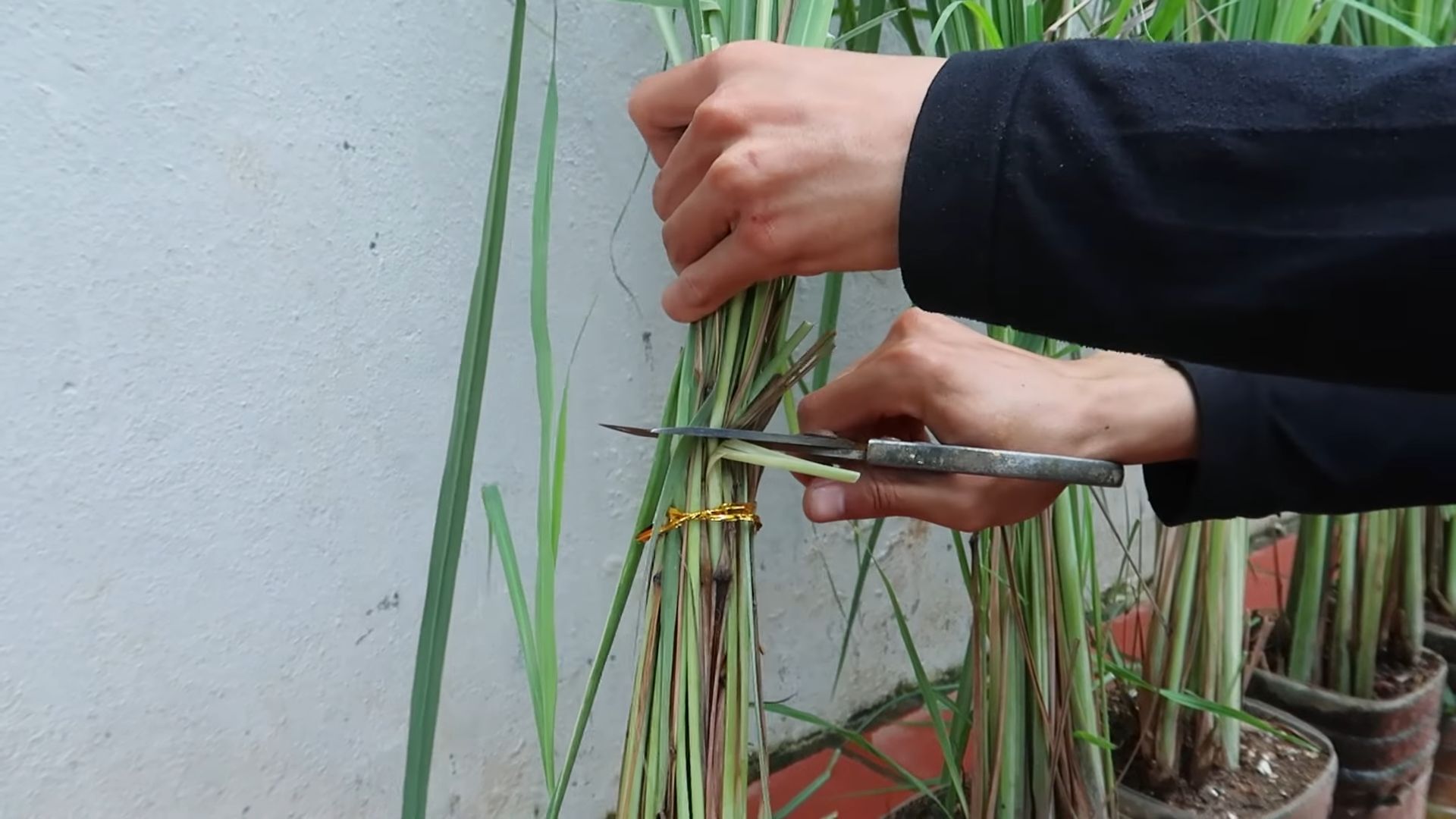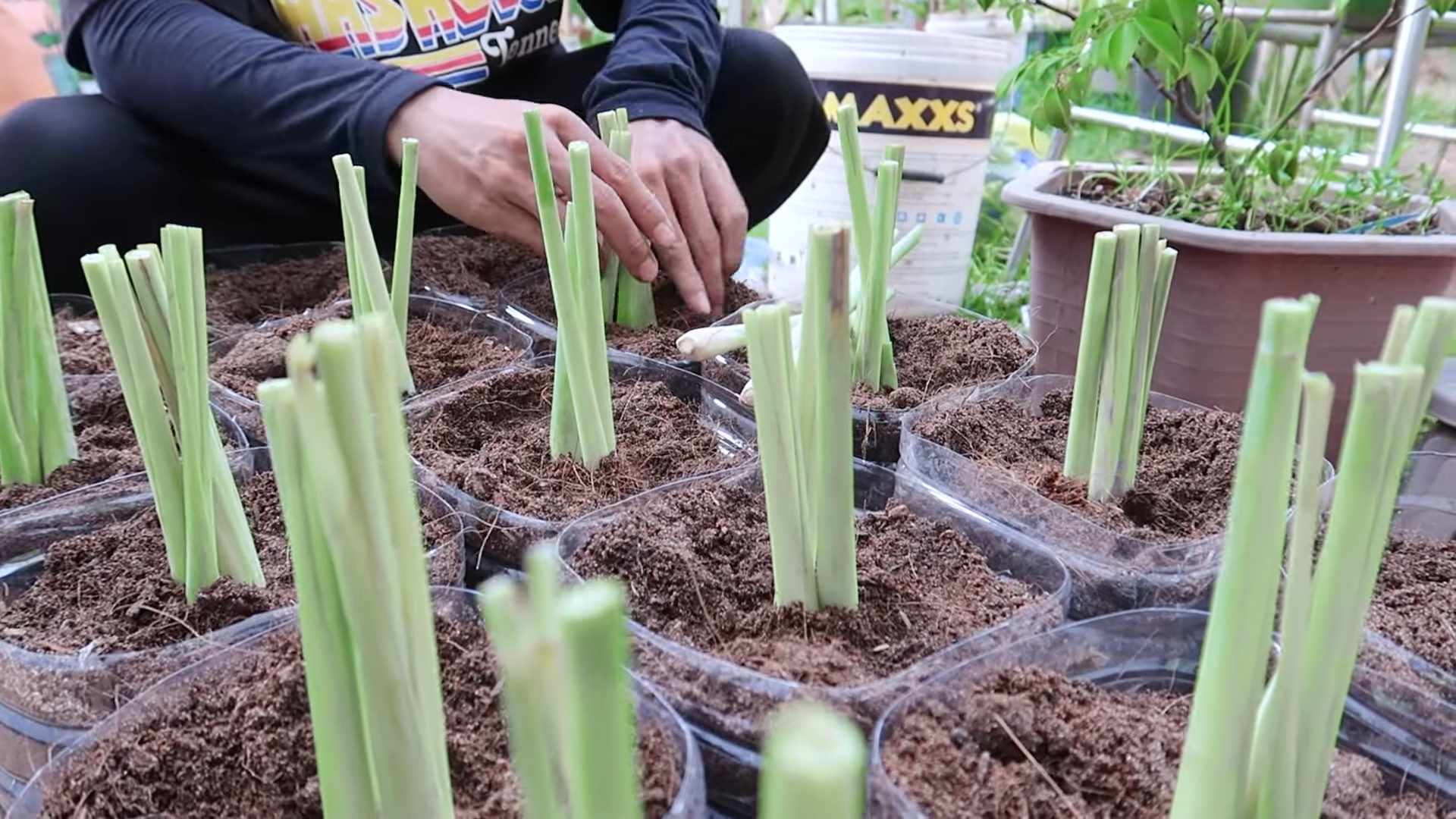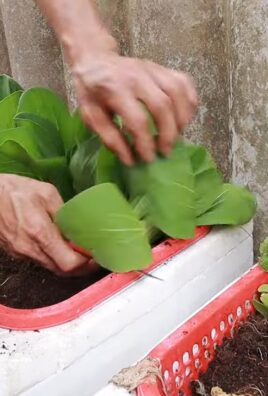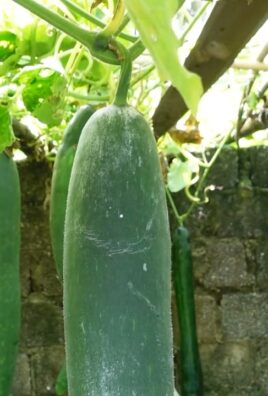Grow Lemongrass Easily, right in your own backyard! Imagine stepping outside and snipping fresh, fragrant lemongrass whenever you need it for a delicious Thai curry or a soothing cup of tea. No more expensive trips to the grocery store or settling for wilted, lackluster stalks. This isn’t just a dream; it’s an achievable reality with a few simple DIY tricks!
Lemongrass, with its vibrant citrusy aroma, has been a staple in Asian cuisine and traditional medicine for centuries. Originating in Southeast Asia, it’s revered not only for its culinary uses but also for its potential health benefits, from aiding digestion to repelling pesky insects. For generations, families have passed down secrets to cultivating this versatile herb, and now, I’m excited to share some of those time-tested techniques with you.
Why should you learn to grow lemongrass easily at home? Well, beyond the convenience and cost savings, it’s incredibly rewarding to nurture your own food. Plus, store-bought lemongrass often lacks the intense flavor and freshness of homegrown varieties. In this article, I’ll guide you through easy-to-follow DIY methods, from propagating from store-bought stalks to creating the perfect growing environment. Get ready to unlock the secrets to a thriving lemongrass patch and elevate your culinary creations!

Grow Your Own Lemongrass: A Simple DIY Guide
Hey there, fellow plant enthusiasts! Ever wanted to add that fresh, citrusy zing of lemongrass to your cooking without constantly running to the store? Well, you’re in luck! I’m going to walk you through a super easy DIY method to grow your own lemongrass, right at home. Trust me, it’s simpler than you think, and the rewards are incredibly flavorful.
What You’ll Need
Before we dive in, let’s gather our supplies. This is a pretty low-key project, so you probably have most of this stuff already.
* Lemongrass Stalks: You can usually find these at your local Asian grocery store. Look for stalks that are firm, healthy-looking, and have a bit of root end still attached. The fresher, the better!
* A Glass or Jar: Something tall enough to hold the lemongrass stalks upright.
* Water: Tap water is fine.
* Potting Soil: A good quality potting mix will do the trick.
* A Pot: Choose a pot that’s at least 6 inches in diameter and depth. Lemongrass can get pretty big, so you might eventually need to upgrade to a larger pot.
* Optional: Rooting Hormone: While not essential, rooting hormone can give your lemongrass a little boost.
* Optional: Fertilizer: A balanced liquid fertilizer will help your lemongrass thrive once it’s established.
Section 1: Rooting Your Lemongrass Stalks
This is where the magic begins! We’re going to coax those lemongrass stalks into sprouting roots.
Step 1: Preparing the Stalks
First things first, let’s get those stalks ready for their watery adventure.
1. Trim the Tops: Using a sharp knife or scissors, trim the top of each lemongrass stalk, leaving about 4-5 inches of the stalk intact. This helps the plant focus its energy on root development rather than leaf growth.
2. Remove Dry or Damaged Leaves: Gently peel away any dry or damaged outer leaves from the base of the stalk. You want to expose the fresh, healthy part of the stalk that will be submerged in water.
Step 2: Water Propagation
Now, let’s get those roots growing!
1. Place Stalks in Water: Fill your glass or jar with enough water to cover the bottom 2-3 inches of the lemongrass stalks. Make sure the stalks are standing upright.
2. Find a Sunny Spot: Place the glass or jar in a bright, sunny location. A windowsill that gets plenty of sunlight is ideal.
3. Change the Water Regularly: This is important! Change the water every 1-2 days to keep it fresh and prevent bacteria from growing. This will also provide the lemongrass with fresh oxygen.
4. Be Patient: It usually takes about 2-3 weeks for roots to start appearing. Don’t get discouraged if you don’t see anything happening right away. Just keep changing the water and giving them plenty of sunlight.
Step 3: Monitoring Root Growth
Keep a close eye on your lemongrass stalks.
1. Check for Root Development: After a week or two, you should start to see small white roots emerging from the base of the stalks.
2. Wait for Sufficient Root Growth: Allow the roots to grow to about 1-2 inches long before transplanting them into soil. This will give them a good head start.
Section 2: Planting Your Rooted Lemongrass
Once your lemongrass has developed a nice set of roots, it’s time to move it to its permanent home in a pot.
Step 1: Preparing the Pot
Let’s get our pot ready for its new resident.
1. Choose the Right Pot: As I mentioned earlier, a pot that’s at least 6 inches in diameter and depth is a good starting point. Make sure the pot has drainage holes to prevent waterlogging.
2. Fill with Potting Soil: Fill the pot with a good quality potting mix, leaving about an inch of space at the top.
Step 2: Transplanting the Lemongrass
Time to move our rooted stalks into their new home.
1. Create a Hole: Use your finger or a small trowel to create a hole in the center of the potting soil, large enough to accommodate the roots of the lemongrass stalk.
2. Gently Remove the Stalk: Carefully remove the lemongrass stalk from the water, being careful not to damage the roots.
3. Place the Stalk in the Hole: Gently place the lemongrass stalk into the hole, making sure the roots are spread out.
4. Cover the Roots with Soil: Fill the hole with potting soil, gently pressing down around the base of the stalk to secure it in place.
5. Water Thoroughly: Water the newly planted lemongrass thoroughly until water drains out of the drainage holes. This will help settle the soil and ensure the roots are properly hydrated.
Step 3: Caring for Your Newly Planted Lemongrass
Now that your lemongrass is planted, it’s time to give it the care it needs to thrive.
1. Sunlight: Lemongrass loves sunlight! Place your pot in a location that receives at least 6 hours of direct sunlight per day.
2. Watering: Keep the soil consistently moist, but not waterlogged. Water when the top inch of soil feels dry to the touch. During hot weather, you may need to water more frequently.
3. Fertilizing: Feed your lemongrass with a balanced liquid fertilizer every 2-3 weeks during the growing season (spring and summer). This will help it grow strong and healthy.
4. Pruning: As your lemongrass grows, you can prune it to encourage bushier growth. Simply trim the leaves as needed. You can also harvest the stalks for cooking as they mature.
5. Overwintering: If you live in an area with cold winters, you’ll need to bring your lemongrass indoors before the first frost. Place it in a sunny location and reduce watering during the winter months.
Section 3: Harvesting and Using Your Lemongrass
The best part! Let’s talk about harvesting and using your homegrown lemongrass.
Step 1: Harvesting
Knowing when and how to harvest is key.
1. When to Harvest: You can start harvesting lemongrass stalks when they are at least 1/2 inch in diameter and about 12 inches tall.
2. How to Harvest: Use a sharp knife to cut the stalks near the base of the plant. You can harvest individual stalks as needed, or harvest a larger portion of the plant at once.
3. Leave the Roots: Be sure to leave the roots intact so the plant can continue to grow.
Step 2: Using Your Lemongrass
Endless possibilities await!
1. In Cooking: Lemongrass is a staple in Southeast Asian cuisine. It can be used to flavor soups, stews, curries, stir-fries, and marinades. To use lemongrass in cooking, simply bruise the stalk to release its flavor, or finely chop it.
2. In Tea: Lemongrass tea is a refreshing and healthy beverage. Simply steep a few chopped lemongrass stalks in hot water for 5-10 minutes.
3. In Aromatherapy: Lemongrass essential oil is known for its uplifting and energizing properties. You can use it in a diffuser or add a few drops to a bath.
Troubleshooting
Even with the best intentions, sometimes things don’t go exactly as planned. Here are a few common issues you might encounter and how to address them:
* Yellowing Leaves: This could be a sign of overwatering or underwatering. Check the soil moisture and adjust your watering accordingly. It could also indicate a nutrient deficiency, so try fertilizing your lemongrass.
* Slow Growth: This could be due to insufficient sunlight or nutrients. Make sure your lemongrass is getting enough sunlight and fertilize it regularly.
* Root Rot: This is usually caused by overwatering. Make sure your pot has good drainage and allow the soil to dry out slightly between waterings.
* Pests: Lemongrass is generally pest-resistant, but occasionally you might encounter aphids or spider mites. Treat infestations with insecticidal soap or neem oil.
And there you have it! Growing your own lemongrass is a rewarding and relatively easy DIY project. With a little patience and care, you’ll be enjoying the fresh, citrusy flavor of homegrown lemongrass in no time. Happy gardening!

Conclusion
So, there you have it! Growing lemongrass easily at home is not only achievable but also incredibly rewarding. Forget those expensive trips to the grocery store for a few sad stalks. With this simple DIY trick, you can have a thriving supply of fresh, fragrant lemongrass right at your fingertips. Imagine the possibilities: vibrant Thai curries, refreshing lemongrass tea, aromatic soups, and even natural insect repellent – all powered by your own homegrown goodness.
This method is a game-changer because it bypasses the often-tricky process of starting lemongrass from seed. By rooting store-bought stalks, you’re essentially giving yourself a head start, ensuring a much higher success rate. Plus, it’s a fantastic way to reduce food waste and embrace a more sustainable lifestyle.
But the fun doesn’t stop there! Feel free to experiment with different varieties of lemongrass. While the common *Cymbopogon citratus* is widely available and perfect for culinary uses, you might also explore other species for their unique aromas and potential medicinal properties. Consider planting your lemongrass in different types of containers – terracotta pots, raised beds, or even directly in your garden. Observe how the different environments affect its growth and flavor.
Don’t be afraid to get creative with your lemongrass harvest! Beyond cooking, you can dry the leaves for potpourri, infuse them in oils for massage, or even use them to create natural cleaning solutions. The possibilities are truly endless.
We wholeheartedly encourage you to give this DIY trick a try. It’s easy, affordable, and incredibly satisfying. Once you’ve experienced the joy of harvesting your own fresh lemongrass, you’ll never want to go back to buying it from the store.
And most importantly, we want to hear about your experiences! Share your photos, tips, and stories in the comments below. Let’s create a community of lemongrass enthusiasts and learn from each other’s successes (and occasional mishaps!). Together, we can all enjoy the abundance of this amazing herb. So, grab some lemongrass stalks, get your hands dirty, and start growing your own slice of tropical paradise today!
Frequently Asked Questions (FAQ)
1. What kind of lemongrass should I buy from the store?
Look for lemongrass stalks that are firm, green, and have a bulbous base. Avoid stalks that are dry, brown, or appear wilted. Ideally, choose organic lemongrass to avoid any potential pesticide residue. The base of the stalk is where the roots will emerge, so make sure it’s in good condition. The fresher the lemongrass, the better your chances of successful rooting.
2. How long does it take for lemongrass to root using this method?
Generally, you should start seeing roots emerge within 1-3 weeks. However, the exact time can vary depending on factors such as water temperature, sunlight exposure, and the overall health of the lemongrass stalks. Be patient and change the water every 1-2 days to keep it fresh and prevent bacterial growth.
3. What kind of soil is best for planting lemongrass?
Lemongrass thrives in well-draining soil that is rich in organic matter. A good potting mix specifically formulated for herbs or vegetables will work well. You can also amend your garden soil with compost or aged manure to improve its fertility and drainage. Lemongrass prefers a slightly acidic to neutral soil pH (around 6.0 to 7.0).
4. How much sunlight does lemongrass need?
Lemongrass needs at least 6-8 hours of direct sunlight per day to thrive. Choose a sunny location in your garden or place your potted lemongrass in a spot that receives plenty of sunlight. If you live in a particularly hot climate, you may need to provide some afternoon shade to prevent the leaves from scorching.
5. How often should I water my lemongrass?
Water your lemongrass regularly, especially during hot and dry weather. The soil should be kept consistently moist but not waterlogged. Check the soil moisture by sticking your finger about an inch deep. If the soil feels dry, it’s time to water. In cooler weather, you can reduce the frequency of watering.
6. Can I grow lemongrass indoors?
Yes, you can grow lemongrass indoors, but it requires a sunny location and consistent care. Place your potted lemongrass near a south-facing window that receives plenty of sunlight. You may also need to supplement with artificial grow lights, especially during the winter months. Ensure good air circulation to prevent fungal diseases.
7. How do I harvest lemongrass?
To harvest lemongrass, simply cut off the stalks near the base of the plant. Use a sharp knife or pruning shears to make a clean cut. You can harvest individual stalks as needed or cut back the entire plant to encourage new growth. The lower portion of the stalk, near the bulb, is the most flavorful.
8. Is lemongrass a perennial or an annual?
Lemongrass is a perennial in warm climates (USDA zones 9-11). In colder climates, it is typically grown as an annual or overwintered indoors. If you live in a cold climate, you can bring your potted lemongrass indoors before the first frost and keep it in a sunny location until spring.
9. How do I overwinter lemongrass in cold climates?
To overwinter lemongrass indoors, cut back the foliage to about 6 inches. Place the potted lemongrass in a sunny location and water sparingly, allowing the soil to dry out slightly between waterings. Avoid fertilizing during the winter months. In the spring, gradually acclimate the lemongrass to outdoor conditions before planting it back in the garden.
10. What are some common problems with growing lemongrass?
Some common problems with growing lemongrass include root rot (caused by overwatering), spider mites, and fungal diseases. To prevent root rot, ensure that your soil is well-draining and avoid overwatering. Spider mites can be controlled with insecticidal soap or neem oil. Fungal diseases can be prevented by providing good air circulation and avoiding overhead watering.
11. Can I propagate lemongrass from cuttings?
Yes, you can propagate lemongrass from cuttings, which is essentially what this DIY trick is all about! By rooting store-bought stalks in water, you’re creating new plants from cuttings. This is a much easier and faster method than starting from seed.
12. Is lemongrass safe for pets?
While lemongrass is generally considered safe for pets in small amounts, it’s best to keep them from consuming large quantities. Some pets may experience digestive upset if they eat too much lemongrass. If you have pets that are prone to chewing on plants, consider placing your lemongrass in a location that is inaccessible to them.
13. Can I use lemongrass as a natural insect repellent?
Yes, lemongrass contains citronella oil, which is a natural insect repellent. You can crush the leaves and rub them on your skin to repel mosquitoes and other insects. You can also make a natural insect repellent spray by boiling lemongrass leaves in water and then straining the liquid.
14. How can I use lemongrass in cooking?
Lemongrass is a versatile ingredient that can be used in a variety of dishes. It is commonly used in Thai, Vietnamese, and other Southeast Asian cuisines. You can use the lower portion of the stalk, near the bulb, to flavor soups, curries, stir-fries, and marinades. The leaves can be used to make tea or infused in oils and vinegars.
15. Where can I find more information about growing lemongrass easily?
There are many resources available online and in libraries that can provide more information about growing lemongrass. Search for articles, videos, and books on herb gardening, container gardening, and sustainable gardening practices. You can also consult with your local garden center or agricultural extension office for advice specific to your region.




Leave a Comment